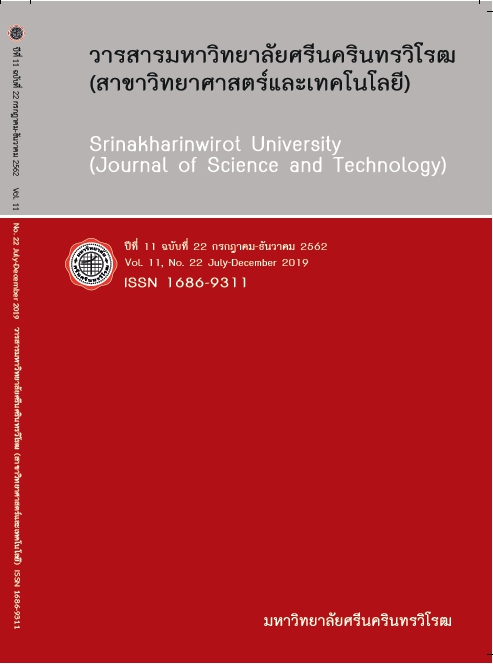ผลของการพรางแสงต่อการเจริญเติบโต ผลผลิตและปริมาณสารเคอร์คูมินในไพล (EFFECT OF SHADING ON GROWTH, YIELD AND CURCUMIN CONTENT OF Zingiber montanum (Koenig) Link ex Dietr. )
คำสำคัญ:
ไพล, ความเข้มของแสง, การเติบโต, ปริมาณสารเคอร์คูมินบทคัดย่อ
การศึกษาผลของการพรางแสงต่อการเจริญเติบโตและปริมาณสารเคอร์คูมินในไพล ดำเนินการระหว่างเดือนกรกฎาคม 2557 ถึงเดือน กุมภาพันธ์ 2558 ณ มหาวิทยาลัยแม่โจ้ จังหวัดเชียงใหม่ วางแผนการทดลองแบบสุ่มสมบูรณ์ ประกอบด้วย 4 กรรมวิธี มี 4 ซ้ำ ได้แก่ ไม่พรางแสง พรางแสงด้วยตาข่ายพรางแสง 50% 70% และ 50% สองชั้น ผลการศึกษาพบว่า ความสูงพุ่มต้น จำนวนใบ ขนาดเส้นผ่าศูนย์กลางลำต้นเทียม จำนวนหน่อ จำนวนหัวย่อย ขนาดหัว น้ำหนักหัว และปริมาณสารเคอร์คูมินในหัว มีค่าเฉลี่ยที่ลดลงตามระดับของการพรางแสงที่เพิ่มขึ้น ในขณะที่การไม่พรางแสงให้ผลดีที่สุดในการส่งเสริมการเจริญเติบโต ผลผลิต และปริมาณสารเคอร์คูมินในหัวไพล ดังนั้นการผลิตไพลให้ได้วัตถุดิบที่มีปริมาณผลผลิตและปริมาณสารสำคัญสูงควรปลูกต้นไพลในสภาพกลางแจ้ง
Downloads
References
[2] Subcommittee on the Preparation of Monographs of Selected Thai Materia Medica. (2012). Monographs of selected Thai materia medica (original draft): Phlai (Zingiber montanum (Koenig) Link ex Dietr.). J. Thai Trad. Alt. Med. 10(1), 52-56.
[3] Antimanon, J., and Sitthisongkram, N. (2004). Formulation Development of Gel Containing Zingiber cassumunar Roxb. Extract. A special project submitted in partial fulfillment of the requirement for the bachelor degree of science in pharmacy. Bangkok: Faculty of Pharmacy, Mahidol University.
[4] Temsiririrkkul, R., Prathanturarug, S., Chuakul, W., and Kheawwongjun, J. (2012). Thai Herbs and Formulas: Academic Usage. Bangkok: Sam Lada LP., Ltd.
[5] Jeenapongsa, R., Yoorathaworn, K., Pongprayoon, U., and Sriwatanakul, K. (2003). Anti-inflammatoryactivity of (E)-4-(3,4- methoxyphenyl)butadiene from Zingiber cassumuar Roxb. Journal of Ethnopharmacology. 87, 143-148.
[6] Panthong, A. Kanjanapothi, D. Niwatananun, V.; Tuntiwachwuttikul, P., and Reutrakul, V. (1990). Anti-inflammatory activity of compounds isolated from Zingiber cassumuar. Planta Medica. 56, 655.
[7] Tangyuenyongwatana, P., and Gritsanapan, W. (2016). Standardization of Prasaplai, a Thai traditional preparation for anti dysmenorrhea. Botanics: Targets and Therapy. 6, 1-9.
[8] Kajorncheappunngam, S. (2006). The effect of temperature, time and solvent on an extraction of curcumin from turmeric. KKU Engineering J. 33(3), 225-236.
[9] Tangyuenyongwatana, P. (2012). Phytochemical comparison and quantitative analysis of major constituents in varieties of Zingiber cassumunar Roxb. in Thailand. Full Research Project Report, Thailand Research Fund (TRF).
[10] Mosaleeyanon, K., Zobayed, S.M.A., Afreen, F., and Kozai, T. (2005). Relationships between net photosynthetic rate and secondary metabolite content in St. John’s Wort. Plant Sci. 169, 523-531.
[11] Makino, A., Sato, T., Nakano, H., and Mae, T. (1997). Leaf photosynthesis, plant growth and nitrogen allocation in rice under different irradiances. Planta. 203, 390-398.
[12] Wolff, X.Y., and Coltman, R.R. (1990). Productivity under shade in Hawaii of five crops grown as vegetables in the tropics. J. Amer. Soc. Hort. Sci. 115, 175-181.
[13] Ghasemzadeh, A.; Jaafar, H.Z.E., Rahmat, A., Wahab, P., and Halim, M. (2010). Effect of differentlight intensities on total phenolics and flavonoids synthesis and antioxidant activities in young ginger varieties (Zingiber officinale Roscoe). Molecules. 11, 3885-3879.
[14] Detpiratmongkol, S., Ubolkerd, T., and Yoosukyingsataporn, S. (2012). Effect of Shading on Growth and Yield of Beijing Grass. In The 51st Kasetsart University Annual Conference, pp. 409-416. Bangkok: Kasetsart University.
[15] Diaz-Perez, J.C. (2013). Bell pepper (Capsicum annum L.) crop as affected by shade level: microenvironment, plant growth, leaf gas exchange, and leaf mineral nutrient concentration. HortScience. 48, 175-182.
[16] Inprasit, S. (2002). Effect of shading on growth, yield and quality of Kaempferia parviflora Wall ex Baker. MS. Thesis. Khon Kaen: Faculty of Agriculture, Khon Kaen University.
[17] Pojanagaroon, S. (2009). Effect of shading and mulching on terpenoids, total phenolic contentsand radical scavenging of Kaempferia parviflora Wall ex Baker rhizomes. Journal of Agr. Research & Extension. 26(2), 23-31.
[18] Hossain, M.A., Akamine, H., Ishimine, Y., Teruya, R., Aniya, Y., and Yamawaki, K. (2009). Effects of relative light intensity on the growth, yield and curcumin content of turmeric (Curcuma longa L.) in Okinawa, Japan. Plant Prod. Sci. 12(1), 29-36.
[19] Pasretasut K. (2004). Influence of elevation and harvesting time on growth, yield, and yield quality of turmeric (Curcuma longa Linn.). MS. Thesis. Khon Kaen: Faculty of Agriculture, Khon Kaen University.
[20] Neri, D., Battistelli, R., and Albertiny, G. (2003). Effect of low-light intensity and temperature on photosynthesis and transpiration of Vigna sinensis L. J. Fruit Ornamental Plant Res. 13, 17-24.
[21] Fan, X.X., Xu, Z.G., Liu, X.Y., Tang, C.M., Wang, L.W., and Han, X.L. (2013). Effect of light intensity on the growth and leaf development of young tomato plants grown under a combination of red and blue light. Scientia Hort. 153, 50-55.
[22] Pierson, E.A., Mack, R.N., and Black, R.A. (1990). The effect of shading on photosynthesis, growth, and regrowth following defoliation for Bromus tectorum. Oecologia. 84, 534-543.
Downloads
เผยแพร่แล้ว
How to Cite
ฉบับ
บท
License
วารสารมหาวิทยาลัยศรีนครินทรวิโรฒ สาขาวิทยาศาสตร์และเทคโนโลยี อยู่ภายใต้การอนุญาต Creative Commons Attribution-NonCommercial-NoDerivs 4.0 International (CC-BY-NC-ND 4.0) เว้นแต่จะระบุไว้เป็นอย่างอื่น โปรดอ่านหน้านโยบายของวารสารสำหรับข้อมูลเพิ่มเติมเกี่ยวกับการเข้าถึงแบบเปิด ลิขสิทธิ์ และการอนุญาต


